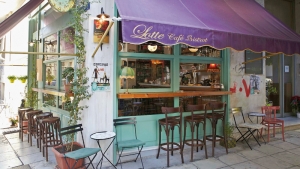BUSINESS CENTRE
XpatAthens
The Best Spots For Food & Coffee In Koukaki
Koukaki has always been a popular neighbourhood in Athens, but recent additions to the area have made it that much more attractive to locals and visitors alike. Here are some of the area's best picks for food and coffee that will surely have you returning for more!
The Fabrica Of Euphrosinos
Address: An. Zini 34, 117 41
Hours: Weekdays: 11.00-23.00, Friday-Saturday: 11.00-1.00
This new hot spot is a real food factory by George Gatsos who studied theology in Belgrade and passed through the kitchens of Mount Athos as a student. Gatsos' love for the authentic comes through in atmosphere and flavors. The decor is simple, by Serbian artist Gora, the food is delicious the wine selection unique from various small producers. The name of the restaurant is a dedication to Saint Euphrosinos, the patron saint of cooks. Euphrosinos is a busy spot so don't be suprised if it's full even if you visit mid week.
Address: Zan Moreas 28 & Falirou 84, 117 41
Price per person: € 10
Hours: Weekdays: 11.00-18.00, Friday - Saturday until late.
In the kitchen at Garyfallo-Kanella you'll find Dimos and his mother. The menu consists of homemade traditional Greek mezedes dishes and the bread is also made in-house. On Fridays and Saturdays they're open late and serve traditional dishes from Asia Minor. Prices are great and they offer a delivery service within central Athens.
Address: Makriyianni 10 & Falirou, 117 42
Price per person: € 22 - 25
Hours: Open daily and on weekends - closed on Sunday night.
This restaurant made Mani sausage with 'siglino' (celery) fashionable and with a 10 year history, its cuisine honors the traditions of its southern Greek origin. Fava, village hot dogs, giouvetsi (beef in tomato sauce) and pork with spinach all have an interesting twist from chef Alexandros Foroulis. It's location is perfect and offers a quiet oasis from the bustle of the city. Prices are at mid-range restaurant level and they also offer half portions at half the price too!
Address: G. Olympiou 7, 117 41
Price per person: € 10
Hours: Daily from 10.00-3.00
Located on the pedestrian walkway of Olympiou, this local gathers many people! Port Valparaiso in Chile was the inspiration for the name. The excellent design, great cocktails and amazing coffees of rare varieties all come together perfectly.
Pagaki
Address: Olympou 17, 117 41
Price per person: 10€
Hours: Daily from 11.00-00.00
Pagaki, meaning bench in English, is a collective-urban partnership where everyone works for everyone. The food options are few and excellent, including anchovies, beans, lemon flavored pork lemon and are all € 4 or less. Wi-fi is free and Pagaki is one of the few spots with excellent access for the disabled.
Lotte
Address: Tsami Karatasou 2, 117 42
Price per person: 10€
Hours: Daily from early in the morning
Lotte reminds you of a cfe that you'd find in Monmarte. It's small, vintage, and if you close your eyes you get the feeling that you're in mum's living room; the tiles are from the Municipal Theatre of Piraeus before it was remodelled. It's the perfect spot for a cup of tea and some hand made cakes!
Guarantee
Address: Veikou 41, 117 42
Price per person: 10€
Hours: Daily from 10.00-17.00
A gourmet sandwich spot that made sandwiches fashionable, Guarantee is celebrating 27 years of service. After this many years its inevitable to have a number of fans who love their famous cold cuts, roast beef and fluffy buns. Make a sandwich of your choice and combine it with a yummy fresh juice.
Tahinosoupa - Tahini Soup
Ingredients
- 6 cups of water
- 2 tsp salt
- 2/3 cup small pasta (Italian stars or Greek Misko peponi)
- 1/4 cup celery, grated (about 2 stalks)
- 1/4 cup scallions, sliced very thin (2-3)
- 1/3 cup grated carrots (1/2 medium carrot)
- 1/4 cup chopped parsley
- 1/3 cup tahini, mixed well
- 1/4 cup fresh squeezed lemon juice
Athens Named World Book Capital For 2018 By UNESCO
The aim of the program is to make books accessible to the city’s entire population, including migrants and refugees. Members of the Advisory Committee also praised Athens’ cultural infrastructure and its expertise in organizing international events. The programs promoted by Athens range from events for writers, translators, illustrators, concerts, exhibitions as well as promotion of poetry via readings and workshops.
Athens prepares for a great celebration, an experience unlike any other! A whole year full of books, reading, culture and events that promote knowledge.Athens prepares for a great celebration, an experience unlike any other! A whole year full of books, reading, culture and events that promote knowledge.
Whether younger or older, Athenian or visitor; all are welcome to join the festivities.
Our aim? To bring books to every neighbourhood and to every corner of the city. street. This is one of the most solemn experiences one can have during Easter in Greece.
For more information, please visit: Athens WBC 2018
Aegean Airlines And Giannis Antetokounmpo Promote ‘Greece By Greeks’ Campaign
“Aegean Airlines and Giannis invite you to visit greecebygreeks.gr and share the small secrets of our beautiful country with the millions of foreign travelers who visit Greece every year,” Aegean recently said.
Hospitality Sponsors Embrace “Santorini Experience”
Summer has arrived, and as we approach the holidays, we also move into the rhythms of “Santorini Experience”, and participants need to book their stay in the breathtaking island of the Cyclades, for October 5-7, 2018, taking advantage of the discounts offered by the hospitality sponsors that apply to this specific period for the event.
Registration and special offers continue with an undiminished pace, with the local community offering its very best, as hospitality sponsors are loyal to their “appointment” this year, offering dynamic support to the island and special accommodation prices to those participating in Santorini Experience.
Hospitality Sponsors are: Santorini Hoteliers Association, Meltemi Hotels & Resorts, Aqua Vista Hotels, Athina Luxury Suites, Santo Maris Oia Luxury Suites & Spa, West East Suites, Desiterra Luxury Suites & Villas, 270 Oia’s View, Central Fira Hotel, Fanouris Condo, Monolithia, Casa Iphigenia, Sienna Resort.
Registrations will close on August 31, 2018. Register now HERE!
For those choosing to travel to the island by plane, Ryanair, the official airline partner of the event for the 3rd consecutive year, will connect Santorini with safety and comfort in privileged fares that will be announced soon.
At the same time, all those wishing to travel to the island by ferry, will be able to enjoy once again this year the safety and comfort of Blue Star Ferries. The top Greek shipping company offers 50% discount on the ferry tickets and vehicles to all those visiting the event and the island from October 1 st to 12 th 2018. Each person who has completed his/her registration is entitled to the same discount for 3 more people (if these are his/her escorts) or for 4 people (if these are family members).
VitaNTravel, as the official travel agent of the event, will take care and assist all athletes and escorts with information about the ferry routes, ferry tickets, car rentals and accommodation in the island while a special accommodation package has been prepared for the period October 5-7, 2018. You may book this special package for a two- night stay that includes your hotel accommodation, ferry tickets with Blue Star Ferries, in economy class for the itineraries: Piraeus - Santorini (5/10), departure: 07.25 am, arrival: 14.55 pm and from Santorini - Piraeus (7/10), departure: 15.30 pm, arrival:
23.25 pm as well as extra transfers from the hotel to the event venues. The privileged package starts from 130€/person. For more information visit VitaNTravel or call +30 2103249070.
In addition, for the 4 th consecutive year Ford Motor Hellas will strengthen Santorini Experience with its presence, with the safety and efficient engines of its cars, as the official sponsor of the event.
For the first time in Santorini Experience, Hellenic Recovery Recycling Corporation (Herrco) will assist the event. In cooperation with the Municipality of Santorini, they aim at a better environmental control of the event and the promotion of recycling in the island. “Vikos” continues on the side of Santorini Experience for the 4 th consecutive year, as an official supporter offering athletes who will take part, the opportunity to quench their thirst with the natural mineral water “Vikos” which contributes to the better functioning of the body.
As far as the open water swimming race is concerned, we must highlight that any event involving an open water swimming race should take place with the approval of the Hellenic Swimming Federation, in accordance with FINA’s safety rules; as is always the case with “Santorini Experience”.
Watch the video teaser of Santorini Experience 2018 HERE!
In addition, official sponsors of the event are once again Alafouzos Sport and Athina Luxury Suites. Official supporters are Avance, Santorini Hoteliers Association, Meltemi Hotels & Resorts, Aqua Vista Hotels, Santo Maris Oia Luxury Suites & Spa and Boatmen Union Santorini. National Geographic is for one more year a Strategic Partner of the event.
“Santorini Experience” is a co-organization of Municipality of Santorini, Municipal Sports Cultural Environmental Organization of Santorini (DAPPOS) and Active Media Group. The event is held for one more year under the auspices of the Greek National Tourism Organization. More info at: www.santorini-experience.com
Official Airline Partner: Ryanair
Official Sponsors: Ford Motor Hellas, Blue Star Ferries, Alafouzos Sport, Athina Luxury Suites
Official Supporters: Natural Mineral Water “Vikos”, Avance Rent A Car, Santorini Hoteliers
Association, Meltemi Hotels & Resorts, Aqua Vista Hotels, Santo Maris Oia Luxury Suites & Spa, Boatmen Union Santorini Assisted by: Lifeguard Patrol, Assyrtico Wine Restaurant Café, Hellenic Recovery Recycling Corporation
Official travel agent: VitaNTravel
Strategic Partner: National Geographic
Official Hashtag: #SantoriniExperience
Photo Credit: Santorini in October @ Santorini Experience by Elias Lefas
Dimitris - From Law student In The UK To Multi-Entrepreneur And Founder Of TEDxAthens
- Easily bored
- Tech lover
- People person
- Decisions made on gut feel
- Thrives on content creation

Greek-Australian Professor Discovers An Unmapped Area In The Human Brain
Named the ‘Endorestiform Nucleus’, this part of the brain is located in the lower cerebellum section, an area that combines sensory and kinetic information to correct posture, balance, and fine motor skills.
How To Start A Great School Year
August Full Moon At The Acropolis Museum
For more information, please click HERE!
A Νew Online Hub For The SNF Health Initiative
In 2016, the Stavros Niarchos Foundation (SNF) initiated a process of investigating areas of possible support for public health in Greece. Building on a long track record of grantmaking in the area of health since 1996, SNF engaged experts to identify and map community needs and held dedicated discussions with the Greek state. As an outcome of the latter, in September 2017, SNF officially announced its intention to fully support a series of major projects to enhance the country’s public health sector. On March 21st, 2018, SNF and the Greek State signed a Memorandum of Understanding marking the start of SNF’s Health Initiative in Greece.
To date, the Health Initiative encompasses 17 constituent projects, with the Health Initiative S.A. serving as the special purpose vehicle set up by SNF to facilitate their coordination and implementation as well as a transparent and participatory process at every stage.
To learn more about this new initiative visit snfhi.org











